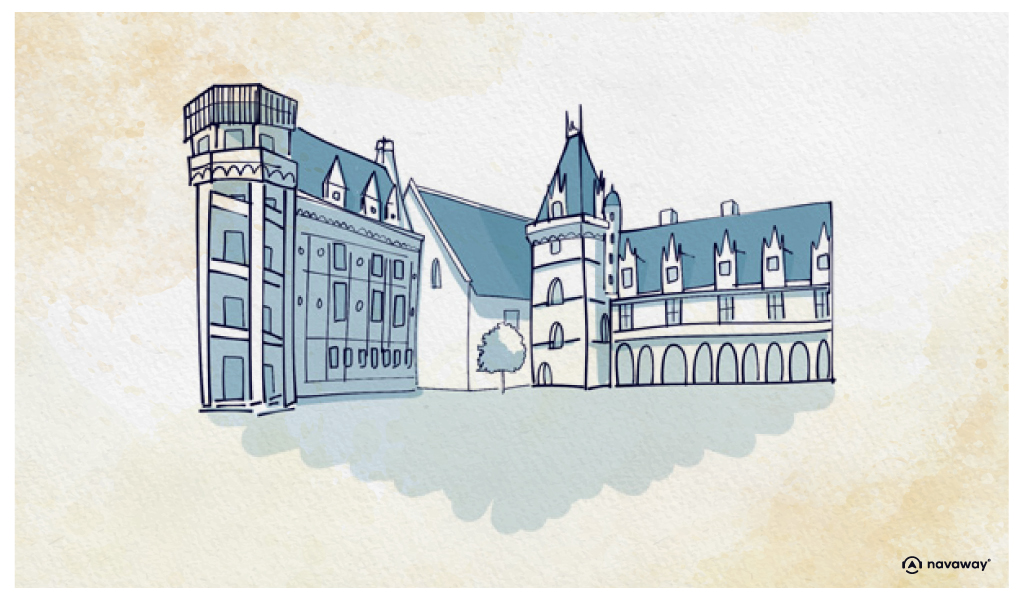
Royal Castle of Blois

This point of interest is available as audio on the tour: Visit Blois, Castle life in the Loire Valley
Introducing the Royal Castle of Blois, the crown jewel of the Loire Valley, known for its great history and architecture. It was a favorite residence of French royalty and has seen centuries of royal dramas, schemes and power plays. You see, it has welcomed a total of seven kings and ten queens. Each owner has left their mark on the building, in keeping with the era they reigned in. As you walk around the castle, you’ll journey through centuries of architectural styles, from the Middle Ages right up to the 17th century. But let’s take things from the start, shall we? Back in the 9th century, the Counts of Blois built a fortress overlooking the city and the Loire River. All that remains today, after centuries of alterations and expansions, are parts of the ramparts, the “Foix” Tower and the Great Hall of 1214, also known as the “Estates-General Hall.” The latter name was due to King Henry III, who convened the Estates General here in 1576 and 1588, in an effort to put an end to the Wars of Religion, weakening the kingdom. The building was split into two naves by a series of columns, and is said to be the oldest seigneurial hall in the country. In 1498, Louis XII, son of the prince and poet Charles d’Orléans, became King of France and chose the Castle of the Counts of Blois as his primary residence. Finding the medieval fortress lacking in comfort, the monarch had a new wing built – the Louis XII wing – befitting a true urban palace. The edifice is a fine example of the flamboyant Gothic style, in keeping with the trends of the time, with some Renaissance elements. The building features alternating brick and stone facades, intricately decorated windows and skylights, a beautiful equestrian statue of the king above the main gate, and, of course, the Saint-Calais Chapel in the courtyard. In 1515, a new king took the throne. His name was Francis I, also known as the “Builder King.” And he wasn’t named that for nothing! With the help of his wife, Claude de France, daughter of Louis XII, the crowned king redesigned and refurbished the Castle of Blois. His wife refurnished the interiors, while he built a new Renaissance-style wing. As for the courtyard, they added a spiral staircase – a stunning centerpiece that was practical nonetheless. They also built the famous loggias on the facade overlooking the city, inspired by those in the Vatican. After the death of his queen, Francis I moved to Fontainebleau and the castle became a “royal nursery” for his 7 children. Among them was Henry II, crowned King of France in 1547 alongside Catherine de’ Medici. Except for some work on the wing built by Francis I, the royal residence was left unchanged even at the hands of his successors, Francis II, Charles IX, and Henry III. In addition to convening the Estates General, the latter is also infamous for having his enemy, the Duke of Guise, killed by some 30 sword blows. It all happened in a room on the 2nd floor, now open to visitors. Little work was carried out on the castle during the Ancien Régime, with the exception of a corner pavilion built by Queen Marie de’ Medici, as evidenced by an inscription found in the basement of Gaston d’Orléans’ wing. Gaston d’Orléans was the brother of Louis XIII, son of Marie de’ Medici, who inherited the property as a wedding gift after being expelled from the Court. He fell in love with the place and carried out extensive reconstruction work, which was soon brought to a halt due to lack of funds. The result was a building of classical style, with a distinctive window pattern and symmetry. Louis XIV thought it to be “a useless castle, fit only for sale,” and Napoleon I saved it from demolition at the last minute in 1810. Today, the Castle of Blois is a prized heritage site, open to the public for a fee.


Discover Blois with app
An interactive guide through the most beautiful streets, squares, and districts
23 fun audioguides full of historical facts, anecdotes, and legends





Comments